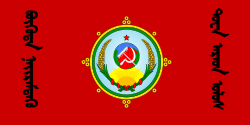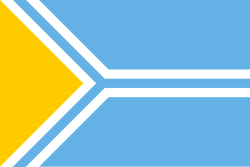| Flag | Years of use | Ratio | Government | Description |
|---|
 | 1918–1921 | 1:2 | Uryankhay Krai | A reconstruction of the flag of the Uryankhay Krai, a short-lived protectorate of the Russian Empire, during the collapse of the empire. The field was light blue and the charge was a Khorlo wheel decorated with a white ribbon. [1] |
 | 1921–1926 | 1:2 | Tannu-Tuva People's Republic | After the proclamation of independence on 14 August 1921 the new republic used an unofficial flag of which there are several reconstructions. [2] [3] |
 | 1921–1926 | 1:2 | Tannu-Tuva People's Republic | Alternate reconstruction. [2] [3] |
 | 1926–1930 | 1:2 | Tuvan People's Republic | The first official flag of Tuva, approved in the 3rd constitution. [2] [3] The inscription reads "Tuvan People's Republic" (Bügüde Nayiramdaqu Tuva Arad Ulus). (24 November 1926 – 18 October 1930) |
 | 1930–1935 | 1:2 | Tuvan People's Republic | Under influence from the Soviet Union, Tuva changed its written language from Mongol script to the Cyrillic script on 28 June 1930. [2] On 18 October 1930 a new constitution changed the flag. [2] [3] Based on the description compared to the 1926 version the Khorlo was removed and the background changed to red. In addition, the inclusion of the inscriptions "TAR" and "Proletarians of the world and the oppressed peoples of the East, unite!" were specified. [2] (18 October 1930 – 2 July 1935) |
 | 1935–1939/1941 | 1:2 | Tuvan People's Republic | On 2 July 1935 the flag and emblem of the country was changed. [2] [3] (2 July 1935 – 1939 / 25 June 1941) |
 | 1939–1941 | 1:2 | Tuvan People's Republic | There existed an alternate version of this flag with only one line of text, [2] which matches the change made to the Tuvan emblem in 1939. [4] [5] Since the flag was simply "red with the emblem in the center" it automatically changed along with the emblem and there was no formal change in the flag until 1941. [5] |
 | 1941–1943 | 1:2 | Tuvan People's Republic | In solidarity with the Soviet Union after the German invasion, Tuva changed its flag in the newly adopted constitution of 1941, to more resemble the flags of the Soviet republics. [2] [3] The flag uses the initials of the state (Tıwa Arat Respublik) (25 June 1941 – 8 September 1943) |
 | 1943–1944 | 1:2 | Tuvan People's Republic | With the adoption of the Cyrillic alphabet in 1943, the flag used Cyrillic letters (Тыва Арат Республик). [2] [3] The Tuvan People's Republic was fully absorbed into the Soviet Union on 11 October 1944, and local flags and symbols were abolished. [2] [5] (8 September 1943 – 11 October 1944) |
 | 1943–1944 | 1:2 | Tuvan People's Republic | A possible variant of the 1943–1944 flag, featuring a hammer and sickle. [3] |
 | 1944–1954 | | Tuvan Autonomous Oblast | In 1944, the USSR annexed Tuva and founded the Tuvan Autonomous Oblast. It did not use a flag of its own. |
 | 1954–1961 |
| 1961–1962 | | Tuvan Autonomous Soviet Socialist Republic | In 1961, the USSR reformed the Tuvan Autonomous Oblast into the Tuvan Autonomous Soviet Socialist Republic, as part of the Russian SFSR. First flag was not created until 1962. |
 | 1962–1971 | 1:2 | Tuvan Autonomous Soviet Socialist Republic | Flag of the Russian Soviet Federative Socialist Republic with the Russian inscription – Тувинская АССР |
 | 1971–1978 | 1:2 | Tuvan Autonomous Soviet Socialist Republic | Flag of the Russian Soviet Federative Socialist Republic with the Russian inscription – Тувинская АССР |
 | 1978–1990 | 1:2 | Tuvan Autonomous Soviet Socialist Republic | Flag of the Russian Soviet Federative Socialist Republic with the Russian – Тувинская АССР and Tuvan inscription – Тыва АССР |
 | 1990–1992 | 1:2 | Tuvan Soviet Socialist Republic (12 December 1990–31 March 1992) and the Republic of Tuva (31 March 1992–17 September 1992) | Flag of the Russian Soviet Federative Socialist Republic with the Russian – Тувинская ССР and Tuvan inscription – Тыва ССР |
 | 1992–2002 | 1:2 | Republic of Tuva | Flag of Tuva from 1992 until 2002. The flag had a ratio of 1:2 |
 | 2002–Present | 2:3 | Republic of Tuva | Current flag |


















